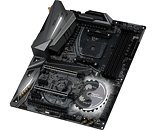- Joined
- Oct 9, 2007
- Messages
- 47,906 (7.37/day)
- Location
- Dublin, Ireland
| System Name | RBMK-1000 |
|---|---|
| Processor | AMD Ryzen 7 5700G |
| Motherboard | Gigabyte B550 AORUS Elite V2 |
| Cooling | DeepCool Gammax L240 V2 |
| Memory | 2x 16GB DDR4-3200 |
| Video Card(s) | Galax RTX 4070 Ti EX |
| Storage | Samsung 990 1TB |
| Display(s) | BenQ 1440p 60 Hz 27-inch |
| Case | Corsair Carbide 100R |
| Audio Device(s) | ASUS SupremeFX S1220A |
| Power Supply | Cooler Master MWE Gold 650W |
| Mouse | ASUS ROG Strix Impact |
| Keyboard | Gamdias Hermes E2 |
| Software | Windows 11 Pro |
AMD X570 is the companion premium chipset option for the company's 3rd generation Ryzen "Matisse" processor family, and is expected to debut alongside the first of these processors some time in June, 2019. Unlike the X470 and X370, the new X570 will be based on an in-house chipset design by AMD, and probably manufactured at GlobalFoundries on its 14 nm node. The mid-range "B550" and lower chipset models could continue to be sourced from ASMedia. Motherboard majors ASUS and ASRock put out their first partial lists of motherboard models based on the AMD X570.
ASUS will launch as many as seven motherboard models in its Republic of Gamers (ROG) family, led by the Crosshair VIII Formula. This indicates that ASUS is placing high enough sales expectations from the "Valhalla" platform across the competitive landscape to come out with an ROG Formula product. You can expect goodies such as 8-layer PCBs, liquid-cooling preparation for the VRM heatsinks, Thunderbolt, or 10 GbE, and the most number of overclocker-friendly features. Next up, are the ROG Crosshair VIII Hero and Crosshair VIII Hero WiFi, which could be the company's second-best product offerings. For the first time on the AMD platform, ASUS will launch an ROG Impact mini-ITX product, with the ROG Crosshair VIII Impact. There will be three ROG Strix family products based on the X570, the Strix-E (premium ATX), Strix-F (mid-range ATX), and Strix-I (premium mini-ITX).

Positioned roughly in-between the Crosshair VIII Formula and Crosshair VIII Hero WiFi, will be the WS X570-ACE, a quasi workstation-grade motherboard based on this platform, which is another first by ASUS for its AMD motherboard product-stack. The mainline Prime series includes the Prime X570-Pro (mid-range) and Prime X570-P (value). There are only two TUF Gaming products, the TUF Gaming X570-Plus, and the TUF Gaming X570-Plus WiFi.
Over to the ASRock camp, and we see its lineup capped by the no-nonsense X570 Taichi. The Taichi brand by ASRock has earned reputation among enthusiasts for its minimalist, yet highly functional design, and a powerful feature-set. This will be closely followed by the X570 Phantom Gaming X. It won't surprise us if these two boards share the same PCB with cosmetic changes to their feature-sets. At the upper-mid segment ASRock is positioning the X570 Phantom Gaming 6. ASRock could heavily implement 2.5 GbE LAN across the upper half of its X570 lineup as a killer-feature. Bang in the middle of the pile is the X570 Phantom Gaming 4, which could command a sub-$150 sweetspot price. This is where the Phantom Gaming segment ends, and the Extreme series begins. The X570 Extreme4 will be the mid-range ATX offering, followed by the X570 Pro4, and X570M Pro4.
View at TechPowerUp Main Site
ASUS will launch as many as seven motherboard models in its Republic of Gamers (ROG) family, led by the Crosshair VIII Formula. This indicates that ASUS is placing high enough sales expectations from the "Valhalla" platform across the competitive landscape to come out with an ROG Formula product. You can expect goodies such as 8-layer PCBs, liquid-cooling preparation for the VRM heatsinks, Thunderbolt, or 10 GbE, and the most number of overclocker-friendly features. Next up, are the ROG Crosshair VIII Hero and Crosshair VIII Hero WiFi, which could be the company's second-best product offerings. For the first time on the AMD platform, ASUS will launch an ROG Impact mini-ITX product, with the ROG Crosshair VIII Impact. There will be three ROG Strix family products based on the X570, the Strix-E (premium ATX), Strix-F (mid-range ATX), and Strix-I (premium mini-ITX).

Positioned roughly in-between the Crosshair VIII Formula and Crosshair VIII Hero WiFi, will be the WS X570-ACE, a quasi workstation-grade motherboard based on this platform, which is another first by ASUS for its AMD motherboard product-stack. The mainline Prime series includes the Prime X570-Pro (mid-range) and Prime X570-P (value). There are only two TUF Gaming products, the TUF Gaming X570-Plus, and the TUF Gaming X570-Plus WiFi.
Over to the ASRock camp, and we see its lineup capped by the no-nonsense X570 Taichi. The Taichi brand by ASRock has earned reputation among enthusiasts for its minimalist, yet highly functional design, and a powerful feature-set. This will be closely followed by the X570 Phantom Gaming X. It won't surprise us if these two boards share the same PCB with cosmetic changes to their feature-sets. At the upper-mid segment ASRock is positioning the X570 Phantom Gaming 6. ASRock could heavily implement 2.5 GbE LAN across the upper half of its X570 lineup as a killer-feature. Bang in the middle of the pile is the X570 Phantom Gaming 4, which could command a sub-$150 sweetspot price. This is where the Phantom Gaming segment ends, and the Extreme series begins. The X570 Extreme4 will be the mid-range ATX offering, followed by the X570 Pro4, and X570M Pro4.
View at TechPowerUp Main Site





